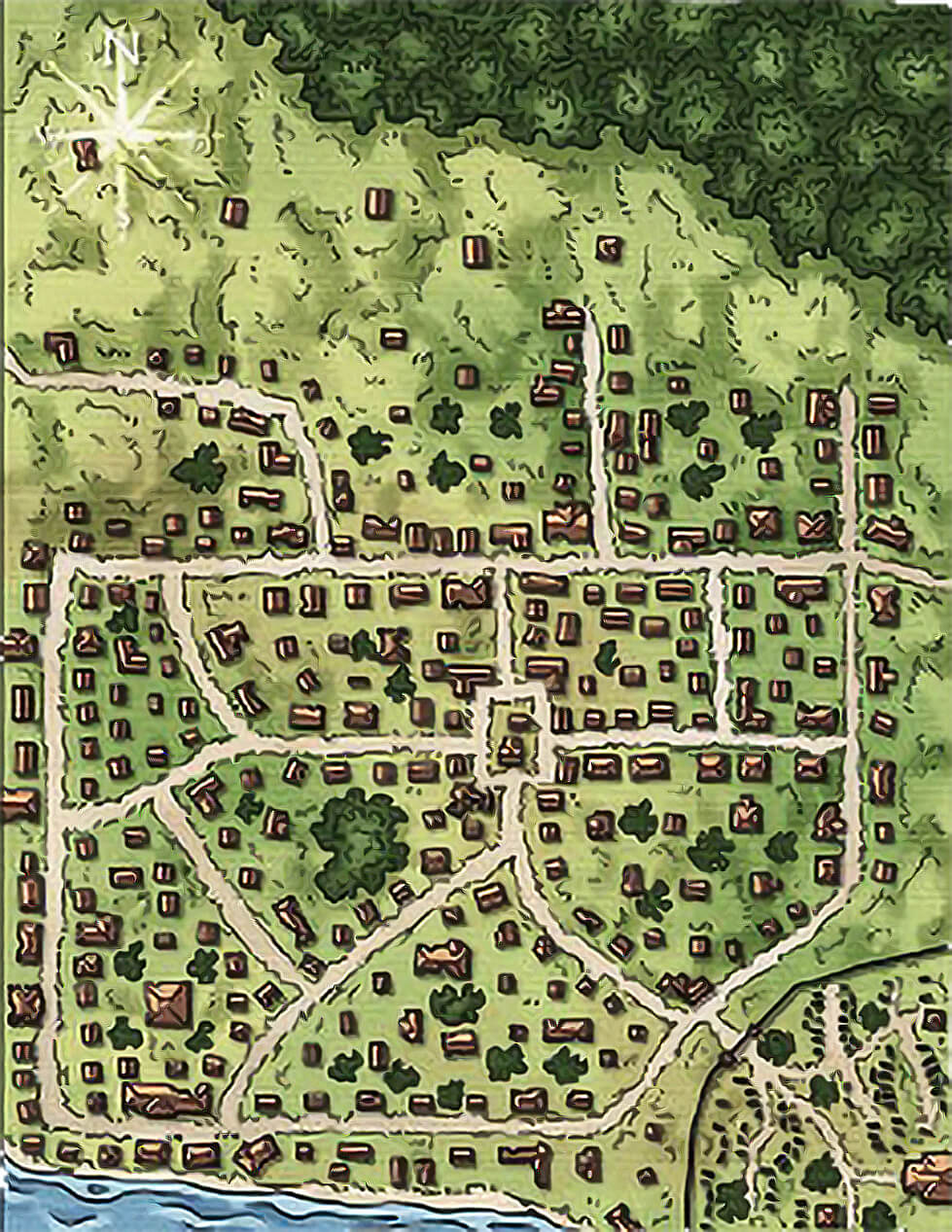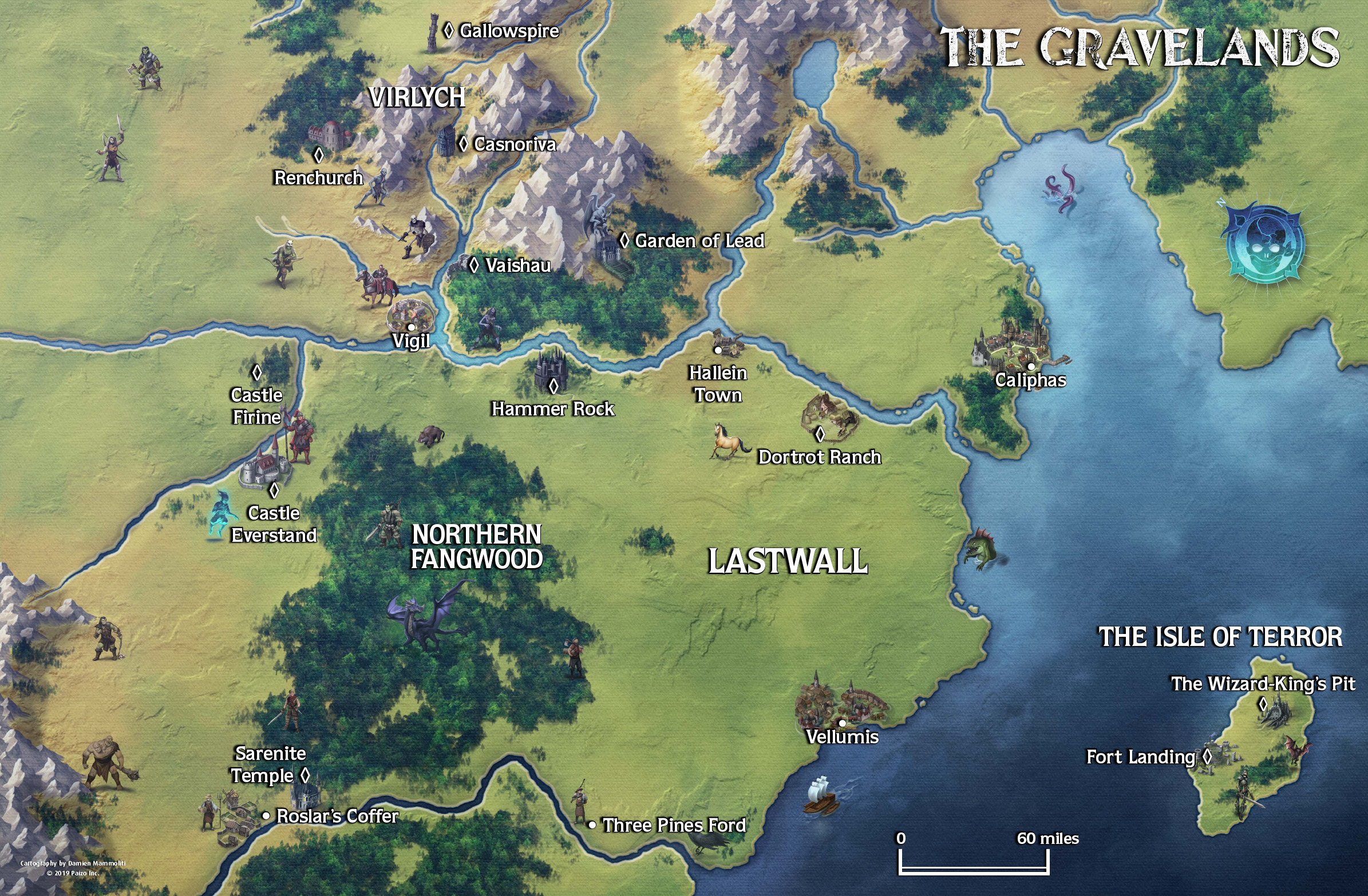Where Are We?!?
"Easy enough to reach the Boneyard—all mortals eventually tread that path of death. Even the living may willingly venture there, at great need. The dead and their eternal judges hold valuable secrets, and many are the heroes and adventurers who have benefited from a journey to the House of Dust. The Histories record that Heristodes traveled there to learn the identity of his father's murderer, and Saint Eveline petitioned the Lady of Graves herself for a weapon to combat the Wraith of Gladsfell. As many have learned, to their peril, the return voyage is more difficult. Safeguards established to prevent the wandering of the dead can easily ensnare the unwary. Best to employ an experienced guide, or equip oneself with potent magical protections, as mortal strength alone is insufficient to return the traveler safely to the world of the living."
— Ambert Lestler, Imperial Historian
Where We Are Now: The Boneyard
The Boneyard

Trapped in the land of the dead, the Survivors of Roslar's Coffer are at the end of the River of Souls, where all the dead prepare themselves for Pharasma's Judgement.
The Boneyard, sometimes referred to as Purgatory or the Spirelands, is a neutral plane where the souls of dead mortals from the Material Plane are judged by the goddess Pharasma. It rests atop Pharasma's Spire, jutting out from Axis into the Astral Plane. Souls are brought to the Boneyard by the River of Souls, and after judgement, are sent to the appropriate plane or domain in the Outer Sphere. Some arrive at the Boneyard with their choices already made or pacts signed, but others are judged by a series of courts.
The Boneyard appears as a vast necropolis filled with countless courtyards, monuments, graves, and forums teeming with the souls of the dead awaiting judgement. Each of these courts is shaped and styled to correspond to one of the Outer Planes, and is overseen and guarded by representatives from each of the gods. The God of the End Times, Groetus, hangs eternally over the Boneyard like a twisted moon that edges closer with each orbit. It is whispered that when he reaches the Spire, all of creation will be wiped away in a great apocalypse.
The souls of the neutral dead remain in the Boneyard and are transformed in the lands beyond Pharasma's palace and the necropolis into aeons. These strange creatures act as the goddess' advisors, caretakers, explorers, guardians, guides, and even soldiers in times of war. The souls of the neutral dead also form into psychopomps who serve as the bureaucracy of death. In the unclaimed wilderness of Boneyard wolf-like packs of esoboks patrol, protecting the restful dead from both mortal and outsider intruders who would disturb them. Crypt dragons are born in the Boneyard, but often prefer to make their permanent lairs on the Material Plane and only return to the Boneyard to escort and represent especially favored souls.
Where We Have Been:
Rosler's Coffer

Named for Ervin Roslar, a hero of the Shining Crusade, the town has survived over 800 years despite sharing a frontier with the orcs of Belkzen, even trading peacefully with several tribes who seasonally wander nearby. Lastwall considers the town, which helps establish the local borders and grows much of the flax used in Vigil, important enough to maintain a small garrison of knights there. While its existence has been challenging, Roslar's Coffer persisted largely without issue for centuries until the more violent Twisted Nail tribe pushed the less aggressive orc tribes out of the region and began launching raids against outlying farms. These attacks eventually escalated until the Twisted Nails assaulted Roslar's Coffer itself in 4707 ar, burning its historic buildings, wiping out over a quarter of the population, and scattering the remaining residents. About half the survivors returned the next season to rebuild, only to discover a territorial creature called a red reaver had moved into the Sarenite monastery a mile outside of town, forcing the church to relocate into the newly rebuilt town itself.
Lastwall deployed additional knights to patrol the border regions as Roslar's Coffer rebuilt. These warriors turned back several new raids by the Twisted Nail, who eventually turned their frustrations inward toward Belkzen. None of the knights' efforts managed to dislodge the red reaver from its new lair, however. It continued to plunder nearby farms and assault travelers, and locals quickly learned to simply avoid the grounds and orchards once managed by the church and otherwise went on with their lives. Agents of the prestigious Pathfinder Society arrived last year to investigate the temple, and after a daring battle, finally felled the beast! The church of Sarenrae has made only brief surveys of the damage caused by the monster in its 10-year stay, and they still operate from town. This sudden burst of excitement nonetheless inspired many of the town's youth to spin fantasies about becoming adventurers and Pathfinders themselves.
In addition to the Sarenite temple, Roslar's Coffer enjoys minor fame for Roslar's Tomb, a sizable crypt in the town cemetery that houses the earthly remains of several heroes from the Shining Crusade (although, ironically, not Roslar himself, after rumors of a scandal arose upon his death). Faithful of both Iomedae and Gorum occasionally visit on pilgrimage to pay their respects to these fallen heroes of the past, and the town is all too happy to provide accommodations in exchange for newcomers' coin. Thanks to its location along the Tourondel River, the town also sees some traffic in the form of crusaders, messengers, pilgrims, and traders from both Lastwall and Nirmathas.
Lastwall At A Glance

Lastwall is a land of rolling grasslands, primeval forests, and ancient battle scars. Once a landscape of orc holds and Kellid city-states dotted with Taldan supply forts, the Whispering Tyrant began to steadily consume the territory after 3200 ar. Orc and Kellid populations were pressed or enslaved into service, with those who fell—either in battle of ill-fated rebellions— animated to serve mindlessly until their bones crumbled to dust. Tar-Baphon's forces razed entire cities and monuments, leaving only buried foundations that now litter the landscape as dungeons and makeshift crypts. By the time Taldor mobilized against the Whispering Tyrant 5 centuries later, generations of gloom and toil had rendered the landscape fallow and hopeless. War left new wounds upon the land. Strongholds and cities built to honor the Whispering Tyrant were torn down to the flagstones and used as the building blocks for new fortifications against the wizard-king. Mass battles left landscapes impregnated with shattered bone and bent steel, with many stretches of land still fetid and unable to support crops. Terrible magic and spirits still haunt many ancient battlefields, even a millennium later.
Despite the horror it has seen, those portions of Lastwall held by mortal hands are beautiful and bountiful. Proximity to Lake Encarthan provides ample rainfall and cool summers, albeit harsh and snowy winters. Growing seasons are long enough to support a variety of crops. The Northern Fangwood Forest and foothills of the Hungry Mountains effectively divide Lastwall in half. Eastern Lastwall is far more urban and reclaimed, with vast farms and ranches supporting cattle and the nation's famous horses, as well as the trade city of Vellumis—an ancient Ustalavic port and the largest city in the nation. Western Lastwall is less tamed and more hostile—an irony, given that the nation's capital of Vigil lies in this untamed half—with frequent incursions from Belkzen orcs, occasional resurgences of necromantic energy, and large tracts of land and forest left largely unexplored and untouched by modern hands. Roslar's Coffer—western Lastwall's southernmost town—exists largely by the grace of the Tourondel River, and little in the way of modern construction exists between it and the fortresses over 100 miles north except a well-guarded stone road and a few hunting lodges. Despite this isolation, the people of Roslar's Coffer squarely consider themselves residents of Lastwall and do what they can to contribute to the nation.
With a strong-hearted and faithful military tradition, the people of Lastwall tend to be community-focused, forthright, and hard working. Their survival depends on trusting each person in the community to do their job to the best of her ability, and every citizen knows his community could fall to the next orc raid or harsh winter if he doesn't give every task his best effort. As a people squeezed between two hostile presences, they are deeply devout, with most residents attending temple services multiple times a week, but as with all things, practicality comes first, and worship must wait if there is work to be done. Most citizens spend the spring planting, summers drilling with weapons and armor, and the autumn harvesting before the first hard freeze. The long, cold winters are a time of respite—orcs rarely campaign in the snow, and freezing temperatures harden the ground and prevent the restless dead from wandering—allowing more attention to hobbies, family, and friends. Feasts and marriages are common in the winter months, though most are generally small, local affairs, as roads during the Lastwall winter can be punishing even for seasoned travelers.

